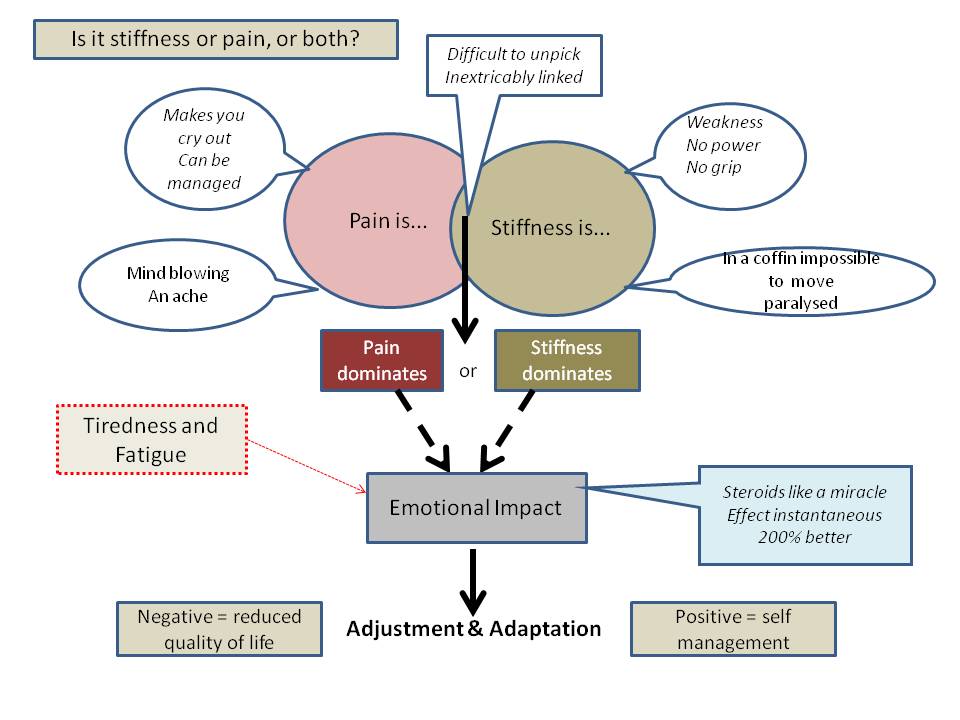Session Information
Session Type: Abstract Submissions (ACR)
Background/Purpose:
Patients with PMR report significant symptoms of pain and stiffness. Stiffness has usually been included in diagnostic criteria for PMR but has never been clearly defined. Stiffness can prove difficult to measure and to distinguish from pain. To try to establish both a definition and a clearer understanding of stiffness in PMR we have performed a qualitative study designed to elicit appropriate patient experience and perception of stiffness.
Methods:
We have conducted 8 focus groups in 3 rheumatology centres in the UK involving 50 patients with PMR. We included one city and two semi-urban units in three regions in the UK to try to explore differences in language or communication across areas. Patients all had English as a first language. Each focus group ran for 1.5 hours, data were transcribed and thematically analysed into codes, sub-themes and themes. Two expert patients with PMR were included in the research from the start of the study. Sample size was designed to reach saturation of themes.
Results:
Themes have emerged in response to direct questioning that relate specifically to definitions of stiffness and measurable outcomes for PMR (deductive thematic anaysis). Through inductive analysis additional themes have emerged; that pain and stiffness were inextricably linked, the use of metaphors to describe PMR symptoms, and an in depth understanding of the cognitive and behavioural impact of polymyalgia.
PMR emerges as a disease of ‘two halves’ with a very close relationship between pain and stiffness. For some, stiffness appears before pain is experienced and can serve as a warning of pain should the person move –‘freezing up in anticipation of pain’. From the data set it appears that patients are dominated either by pain, fatigue or stiffness but there is always a background of stiffness. Metaphorical descriptions of disease relating to stiffness have included ‘tin soldier’, ‘rusty hinge’, ‘2 bricks cemented on my shoulders’ and being ‘trapped in a coffin’. Patients report stiffness in association with sleep disturbance, loss of confidence, mood and stress disorders and a clear temporal variation of symptoms worse at night and in the early morning ‘my 24 hour problem’, ‘a cycle’. Although patients report a very significant improvement in stiffness and pain after treatment with corticosteroids data suggest that they almost always continue to experience stiffness although they may not report this to their physicians. Stiffness both before and after treatment impacts on function, independence and social and working life.
Conclusion:
This work has led us towards a clearer definition of the meaning, experience and impact of stiffness. We have devised an initial thematic model of symptoms in polymyalgia that emerges from our work that will enable us to proceed further towards an adequate definition of stiffness ways of measuring it.
A thematic model of stiffness in PMR

Disclosure:
R. A. Hughes,
None;
S. Mackie,
None;
J. R. Kirwan,
Horizon Pharma (formerly Nitec Pharma), AstraZeneca, CombinatoRx, GlaxoSmithKline, Merck, and Wyeth,
5;
C. T. Pease,
None;
M. Walsh,
None;
M. Morris,
None.
« Back to 2012 ACR/ARHP Annual Meeting
ACR Meeting Abstracts - https://acrabstracts.org/abstract/what-do-patients-with-polmyalgia-rheumatica-mean-when-they-describe-stiffness-a-qualitative-study/
